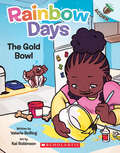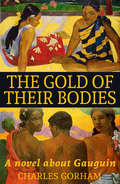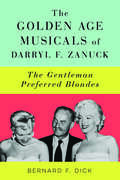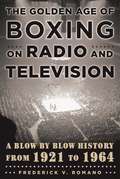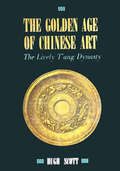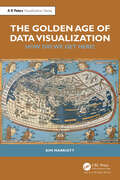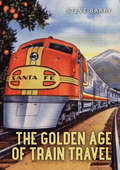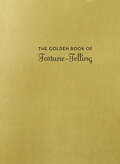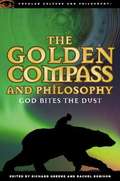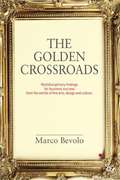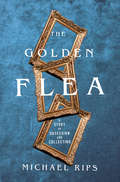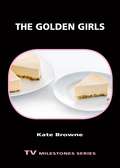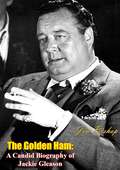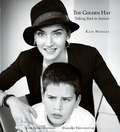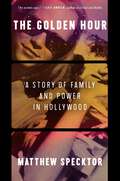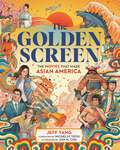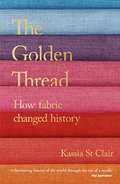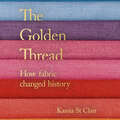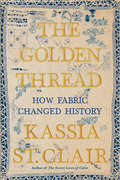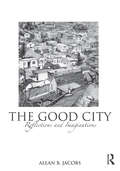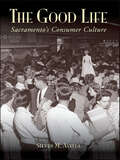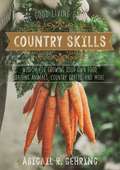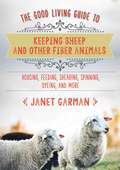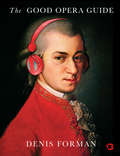- Table View
- List View
The Gold Bowl: An Acorn Book (Rainbow Days)
by Valerie BollingZoya makes Coco a golden birthday present in this full-color book perfect for beginning readers!Pick a book. Grow a Reader!This series is part of Scholastic's early reader line, Acorn, aimed at children who are learning to read. With easy-to-read text, a short-story format, plenty of humor, and full-color artwork on every page, these books will boost reading confidence and fluency. Acorn books plant a love of reading and help readers grow!It’s Coco’s birthday and Zoya wants to give her pup the perfect present. She tries out a few ideas -- including a yarn necklace and colorful frosted treats. But she finally decides to paint Coco’s bowl gold. With some paint and LOTS of glitter, Zoya creates a gift Coco is sure to love!With Kai Robinson's vibrant, full-color artwork and Valerie Bolling's engaging, easy-to-read text throughout, this sparkly series is perfect for beginning readers!
The Gold of their Bodies: A Novel about Gaugain
by Charles GorhamGold of Their Bodies, first published in 1955, is a fascinating biography of Paul Gauguin (1848-1903), the French post-impressionist artist, most famous for his colorful paintings of life in Tahiti and the South Pacific. Although fictionalized by the addition of dialogue, Gold of Their Bodies draws from Gauguin’s own writings and accurately portrays the adult life of Gauguin—his struggles to make a living from his art, his friendships with Van Gogh, Cezanne, Pissaro, and other contemporaries, his travels and life with the native peoples of the South Pacific, his relationships with Polynesian women, and his run-ins with French colonial authorities. Gauguin, prolific in his output (in large part due to the small price he received for his works), and troubled by poor health in his later life, died at the relatively young age of 54 in the Marquesas Islands of French Polynesia. It was not until after his death that his works were recognized as masterpieces, and, in February 2015, one of his Tahitian paintings sold for the staggering price of $300 million dollars.
The Golden Age Musicals of Darryl F. Zanuck: The Gentleman Preferred Blondes
by Bernard F. DickBeginning with The Jazz Singer (1927) and 42nd Street (1933), legendary Hollywood film producer Darryl F. Zanuck (1902–1979) revolutionized the movie musical, cementing its place in American popular culture. Zanuck, who got his start writing stories and scripts in the silent film era, worked his way to becoming a top production executive at Warner Bros. in the later 1920s and early 1930s. Leaving that studio in 1933, he and industry executive Joseph Schenck formed Twentieth Century Pictures, an independent Hollywood motion picture production company. In 1935, Zanuck merged his Twentieth Century Pictures with the ailing Fox Film Corporation, resulting in the combined Twentieth Century-Fox, which instantly became a new major Hollywood film entity.The Golden Age Musicals of Darryl F. Zanuck: The Gentleman Preferred Blondes is the first book devoted to the musicals that Zanuck produced at these three studios. The volume spotlights how he placed his personal imprint on the genre and how—especially at Twentieth Century-Fox—he nurtured and showcased several blonde female stars who headlined the studio’s musicals—including Shirley Temple, Alice Faye, Betty Grable, Vivian Blaine, June Haver, Marilyn Monroe, and Sheree North. Building upon Bernard F. Dick’s previous work in That Was Entertainment: The Golden Age of the MGM Musical, this volume illustrates the richness of the American movie musical, tracing how these song-and-dance films fit within the career of Darryl F. Zanuck and within the timeline of Hollywood history.
The Golden Age of Boxing on Radio and Television: A Blow-by-Blow History from 1921 to 1964
by Frederick V. RomanoRadio and television broadcasting were as important to the growth and popularity of boxing as it was to the reshaping of our very culture. In The Golden Age of Boxing on Radio and Television, Frederick V. Romano explores the many roles that each medium played in both the development and the depiction of the sport. Principal among the topics covered are the ever-changing role of technology during the four-decade-plus period, how it impacted the manner in which the sport was presented to its public audience, the exponential growth of those audiences, and the influence radio and television had on the financial aspects of the sport, including the selective use of radio and television and the financial boom that the mediums created.The Golden Age of Boxing on Radio and Television also assays radio and boxing during World War II, the role of organized crime, and the monopolistic practices during the television era. Romano also presents a detailed account of announcers such as Don Dunphy and Ted Husing who brought the action to the listeners and viewers, the many appearances that boxers including Jack Dempsey, Joe Louis, and Rocky Marciano made on radio and television when they were not in the ring, and the mediums’ portrayal of the sport in an array of programming from drama to comedy. This is a must-have for all serious boxing fans.
The Golden Age of Chinese Art
by Hugh ScottFor almost three hundred years the noble T'ang Dynasty fostered a period of artistic and intellectual endeavor which has never been equaled in the history of China. Sculpture, ceramics, glass, and textiles were some of the major artifacts that emerged from this glorious renaissance of Chinese taste and skill.This book is the story of the T'ang told through objects in the author's collection, one of the most representative in private hands. It includes a marvelous array of gold and silver mirrors, jade, jewelry and gilt bronzes.the 124 illustrations, 24 in full color are accompanied by a history of the T'ang era, and a chapter on each of the categories in the collection gives a comprehensive background to the illustrations.
The Golden Age of Data Visualization: How Did We Get Here?
by Kim MarriottWe are living in the Golden Age of Data Visualization. The COVID-19 pandemic has demonstrated how we increasingly use data visualizations to make sense of the world. Business analysts fill their presentations with charts, journalists use infographics to engage their readers, we rely on the dials and gauges on our household appliances, and we use mapping apps on our smartphones to find our way.This book explains how and why this has happened. It details the evolution of information graphics, the kinds of graphics at the core of data visualization—maps, diagrams, charts, scientific and medical images—from prehistory to the present day. It explains how the cultural context, production and presentation technologies, and data availability have shaped the history of data visualization. It considers the perceptual and cognitive reasons why data visualization is so effective and explores the little-known world of tactile graphics—raised-line drawings used by people who are blind. The book also investigates the way visualization has shaped our modern world. The European Renaissance and the Scientific Revolution relied on maps and technical and scientific drawings, and graphics influence how we think about abstract concepts like time and social connection.This book is written for data visualization researchers and professionals and anyone interested in data visualization and the way we use graphics to understand and think about the world.
The Golden Age of Train Travel
by Steve BarryFor the century after 1865 all the largest railroad companies had flagship luxury trains, spectacularly appointed steamliners offering unrivaled standards of service and thoughtful amenities including ladies' perfume and carnations for gentlemen. These luxury trains transported well-heeled passengers in grand style across spectacular American landscapes in an atmosphere of privilege and elegance. Including the iconic Super Chief of the Sante Fe Railway and New York Central System's fabled 20th Century Limited, they became legends in their day and for decades after their last runs. This beautifully illustrated book allows readers to experience the exhilarating journeys, the exquisitely designed train cars and the vintage advertisements and posters that together made up the passenger's experience during this golden age of train travel - an age still remembered and celebrated today.
The Golden Book of Fortune-Telling (Fortune-Telling)
by K.C. JonesA compendium of fun and entertaining ways to understand your future, taken from entries in the bestselling Fortune-Telling series.In this book lie the answers to your future. Reveal the meanings of your name, birthday, zodiac sign, and dreams. Unveil the significance of your color choices, friendships, and love interests. Discover what is foretold, learn to read auspicious omens, and divine the gift of attracting good fortune. Consult The Golden Book of Fortune-Telling and uncover the wisdom of the ages—and the power to shape your destiny.
The Golden Compass and Philosophy: God Bites the Dust
by Richard Greene Rachel RobisonPhillip Pullman's controversial fantasy trilogy His Dark Materials comes under the scrutiny of Atlantic anglophone scholars of philosophy and religion, and literature and libraries. They reflect on such topics as whether Pullman is corrupting the young, faith and circumcision, the truth in Lyra's lies, kicking up some dust, cutting like a knife, whether the Magisterium could be right, worlds of possibility, and why the dead choose death. The style is informal, irreverent even, as part of the effort to make philosophy accessible to young people and lay readers.
The Golden Crossroads
by Marco BevoloThe art world is booming. Museums are not mere containers of artifacts anymore, they are full blown experience centers and carry the ultimate prestige brand. The novelty in thinking and approaching challenges in the art world is magnified for business readers.
The Golden Flea: A Story Of Obsession And Collecting
by Michael RipsAn enchanting tale of the search for forgotten treasures at one of the greatest flea markets on earth. Across America and around the world, people wander through flea markets to search for lost treasures. For decades, no such market was more renowned than the legendary Chelsea flea market, which sprawled over several blocks and within an old garage on the west side of Manhattan. Visitors would trawl through booths crammed with vintage dresses, rare books, ancient swords, glass eyeballs, Afghan rugs, West African fetish dolls, Old Master paintings, and much more. In The Golden Flea, the acclaimed writer Michael Rips takes readers on a trip through this charmed world. With a beguiling style that has won praise from Joan Didion and Susan Orlean, Rips recounts his obsession with the flea and its treasures and provides a fascinating account of the business of buying and selling antiques. Along the way, he introduces us to the flea’s lovable oddball cast of vendors, pickers, and collectors, including a haberdasher who only sells to those he deems worthy; an art dealer whose obscure paintings often go for enormous sums; a troubadour who sings to attract customers; and the Prophet, who finds wisdom among all the treasures and trash. As Rips’s passion for collecting grows and the flea’s last days loom, he undertakes a quest to prove the provenance of a mysterious painting that just might be the one.
The Golden Girls (TV Milestones Series)
by Kate BrowneThe Golden Girls made its prime-time debut in 1985 on NBC, and the critically acclaimed show has been a constant television companion through cable reruns and streaming media services ever since. Most people know that The Golden Girls is a sitcom about four feisty, older women living together in Miami who love to eat cheesecake, but Kate Browne argues that The Golden Girls is about so much more. Drawing on feminist literary studies and television studies, Browne makes a case for The Golden Girls as a TV milestone not only because it remains one of the most popular sitcoms in television history but also because its characters reflect shifting complexities of gender, age, and economic status for women in the late twentieth century and beyond. Each chapter is dedicated to exploring what makes these remarkable characters defy expectations of how older women should look, act, and love. Chapter 1 focuses on Dorothy Zbornak’s intriguing gender performance and shifting desirability. Chapter 2 digs into Blanche Devereux’s difficult relationship with motherhood and aging. Chapter 3 highlights how Rose Nylund made all the "right" choices in life but consistently finds herself disenfranchised by the same social and economic institutions that promised to protect her at midlife. Chapter 4 centers on how Sophia Petrillo drives the action of the show as a trickster—bending plots to her own desires and offering moral lessons to the other characters. The book offers an important analysis of a hugely popular sitcom that extends the boundary of what makes TV groundbreaking and worthy of study. Browne argues that The Golden Girls is a "classic" sitcom in almost every way, which keeps audiences engaged and allows the show to make subversive moves when it matters most. Written with both superfans and scholars in mind, the book invites new, diverse ways of thinking about the show to spark future scholarship and conversation about four of the most beloved characters in sitcom history.
The Golden Ham: A Candid Biography of Jackie Gleason
by Jim BishopIn his foreword, Jim Bishop says of Jackie Gleason that when the comedian read the manuscript for the Fust time “he did not ask that anything be either omitted or altered. And yet there were parts of this biography that made him wince.”For The Golden Ham is candid biography. To it Mr. Bishop brought his painstaking interest in detail, his reporter’s curiosity, his layman’s interest in the world of the theater, and his detachment. And most important, he began and ended his job with Jackie Gleason’s guarantee that nothing Bishop wrote would be censored.The result is a kind of theatrical biography that is entirely new and, like Gleason himself, is made up of a great deal of a great many things. As Bishop says:“There are several Jackie Gleasons. I know some of them. There is Gleason the comedian. Millions know him, and he’s a great talent. Then there is Gleason the producer and Gleason the writer. Some people know these....Gleason the businessman—second-rate, but he thinks he’s good at it—and then there is Gleason the thinker (apt and fast) and Gleason the man (fat, out of shape, but light on his feet) and Gleason the tenement-house kid from Brooklyn (nervy and not a bit surprised that he’s on top) and Gleason the lover, Gleason the musician, Gleason the moody, and Gleason the lonely, tormented soul.”This is a book about Jackie Gleason. If you like him, it may make you like him more, or less, depending on the kind of person you are. If you never liked him, it may change your mind a little. If you never had any special attitude toward Jackie Gleason, you will have one by the time you have finished this book.
The Golden Hat
by Keli Thorsteinsson Kate Winslet Margret EricsdottirThank you for taking this journey with us. We hope this book brings a new awareness of the opportunity we have to help those with autism learn to communicate and realize their ambitions. People with autism have the potential to achieve great things, but only when given the appropriate support and education. This is why the Golden Hat Foundation was formed. All author proceeds from this book go directly to the Golden Hat Foundation. With your help, we can change the world for people with autism. For more information about the Golden Hat Foundation and ways you can help, please visit our website: www.goldenhatfoundation.org "I simply couldn't conceive of how devastating it would be not to be able to hear my children's voices. Not to be able to communicate with them, to hear them learn, grow, and express themselves verbally. How fortunate, how blessed I am. This overwhelmed me. I can talk to my children, I can respond to their needs and comfort them when they tell me they are unwell. I can tell them stories and hear them tell theirs." Kate Winslet Imagine what it would be like not to be able to communicate with those we love. For many individuals living with nonverbal autism and their families, this is their everyday reality. The Golden Hat is an intimate response to this reality created by Kate Winslet, Margret Ericsdottir, and her son Keli, who has nonverbal autism. Kate and Margret's stories, their personal email correspondence, and Keli's poetry give us a profound insight into the world of those living with autism. Kate has shared this story with some of the world's most famous people, posing the question: "What is important to you to express?" Their responses are a collection of intimate self-portraits and unique quotes. Among them are: Christina Aguilera Zac Efron Julianne Moore Maria Sharapova Kobe Bryant James Franco Rosie O'Donnell Ben Stiller Michael Caine Ricky Gervais Michael Phelps Meryl Streep Kim Cattrall Tom Hanks John C. Reilly Justin Timberlake George Clooney Elton John Tim Robbins Naomi Watts Leonardo DiCaprio Jude Law Kristin Scott Thomas Oprah Winfrey Put together by Kate, Margret, and the dedicated team who work daily on the Golden Hat Foundation, this project has been a labor of love. All the author proceeds from this groundbreaking book will benefit the Golden Hat Foundation, founded by Kate Winslet and Margret Ericsdottir to build innovative living campuses for people with autism and raise public awareness of their intellectual capabilities.
The Golden Hour: A Story of Family and Power in Hollywood
by Matthew SpecktorA personal and cultural exploration of the struggles between art and business at the heart of modern Hollywood, through the eyes of the talent that shaped itMatthew Specktor grew up in the film industry: the son of legendary CAA superagent Fred Specktor, his childhood was one where Beau Bridges came over for dinner, Martin Sheen’s daughter was his close friend, and Marlon Brando left long messages on the family answering machine. He would eventually spend time working in Hollywood himself, first as a reluctant studio executive and later as a screenwriter.Now, with The Golden Hour, Specktor blends memoir, cultural criticism, and narrative history to tell the story of the modern motion picture industry—illuminating the conflict between art and business that has played out over the last seventy-five years in Hollywood. Braiding his own story with that of his father, mother (a talented screenwriter whose career was cut short), and figures ranging from Jack Nicholson to CAA’s Michael Ovitz, Specktor reveals how Hollywood became a laboratory for the eternal struggle between art, labor, and capital.Beginning with the rise of Music Corporation of America in the 1950s, The Golden Hour lays out a series of clashes between fathers and sons, talent agents and studio heads, artists, activists, unions, and corporations. With vivid prose and immersive scenes, Specktor shows how Hollywood grew from the epicenter of American cultural life to a full-fledged multinational concern—and what this shift has meant for the nation’s place in the world. At once a book about the movie business and an intimate family drama, The Golden Hour is a sweeping portrait of the American Century.
The Golden Screen: The Movies That Made Asian America
by Jeff YangFrom a New York Times bestselling author, this groundbreaking book celebrates and examines the history of Asian Americans on the big screen, exploring how iconic films have shaped Hollywood, representation, and American culture. In 2018, the critical and financial success of Crazy Rich Asians ignited new fires in Hollywood to create and back Asian-centric stories. Since then, the number of movies featuring Asian Americans, either in front or behind the camera, has boomed and ushered in a new era of filmmaking. But many films, like The Joy Luck Club in 1993, paved the way for Asian American-led films before Crazy Rich Asians and to today. The Golden Screen is an in-depth look at those films, and the factors that played into their success.The Golden Screen includes commentary and conversations from Hollywood's most visible faces, such as Simu Liu, Lulu Wang, Daniel Dae Kim, Janet Yang, Ronny Chieng, Alice Wu, and Ken Jeong. See the movies that inspired today's modern stars to enter moviemaking, and how they're paying it forward to the next wave of creators. Featuring beautiful, original artwork from nine esteemed Asian illustrators, including: Toma Nguyen, barbarian flower, Jun Cen, Cryssy Cheung, Cliff Chiang, Yu-Ming Huang, JiYeun Kang, Ashraf Omar, and Zi Xu. A beautiful keepsake and collection of over 100 photographs and original art, The Golden Screen is perfect for movie and history fans alike, and reaffirms the importance of the Asian American film canon, and all the people involved, in an increasingly diverse Hollywood.
The Golden Thread: How Fabric Changed History
by Kassia St Clair** A RADIO 4 BOOK OF THE WEEK **'Fascinating . . . The history of the world through the eye of a needle . . . I recommend this book to anyone' THE SPECTATOR'A charming, absorbing and history that takes us on a journey from the silk roads to sportswear, from ruffs to spacesuits . . . I devoured this quietly feminist book' SUNDAY TIMES'Joyful and beautiful' NATURE'Will make you rethink your relationship with fabric' ELLE DECORATIONAll textiles begin with a twist. From colourful 30,000-year old threads found on the floor of a Georgian cave to what the linen wrappings of Tutankhamun's mummy actually meant; from the Silk Roads to the woollen sails that helped the Vikings reach America 700 years before Columbus; from the lace ruffs that infuriated the puritans to the Indian calicoes and chintzes that powered the Industrial Revolution, our continuing reinvention of cloth tells fascinating stories of human ingenuity. When we talk of lives hanging by a thread, being interwoven, or part of the social fabric, we are part of a tradition that stretches back many thousands of years. Fabric has allowed us to achieve extraordinary things and survive in unlikely places, and this book shows you how -- and why.With a cast that includes Chinese empresses, Richard the Lionheart and Bing Crosby, Kassia St Clair takes us on the run with escaped slaves, climbing the slopes of Everest and moonwalking with astronauts. Running like a bright line through history, The Golden Thread offers an unforgettable adventure through our past, present and future.
The Golden Thread: How Fabric Changed History
by Kassia St Clair** A RADIO 4 BOOK OF THE WEEK **'Fascinating . . . The history of the world through the eye of a needle . . . I recommend this book to anyone' THE SPECTATOR'A charming, absorbing and history that takes us on a journey from the silk roads to sportswear, from ruffs to spacesuits . . . I devoured this quietly feminist book' SUNDAY TIMES'Joyful and beautiful' NATURE'Will make you rethink your relationship with fabric' ELLE DECORATIONAll textiles begin with a twist. From colourful 30,000-year old threads found on the floor of a Georgian cave to what the linen wrappings of Tutankhamun's mummy actually meant; from the Silk Roads to the woollen sails that helped the Vikings reach America 700 years before Columbus; from the lace ruffs that infuriated the puritans to the Indian calicoes and chintzes that powered the Industrial Revolution, our continuing reinvention of cloth tells fascinating stories of human ingenuity. When we talk of lives hanging by a thread, being interwoven, or part of the social fabric, we are part of a tradition that stretches back many thousands of years. Fabric has allowed us to achieve extraordinary things and survive in unlikely places, and this book shows you how -- and why.With a cast that includes Chinese empresses, Richard the Lionheart and Bing Crosby, Kassia St Clair takes us on the run with escaped slaves, climbing the slopes of Everest and moonwalking with astronauts. Running like a bright line through history, The Golden Thread offers an unforgettable adventure through our past, present and future.
The Golden Thread: How Fabric Changed History
by Kassia St ClairAs heard on BBC Radio 4's Book of the WeekA new history of ingenuity from the author of The Secret Lives of Colour.From the mummies of Ancient Egypt; via the silken dragon robes of Imperial China and the woollen sails of Viking longboats to the Indian calicoes and chintzes that powered the Industrial Revolution (and sparked more than one war); arriving finally at the lab-blended fibres that have allowed astronauts to moonwalk -- fabrics, manmade and natural, have changed and shaped the world we live in.In twelve fascinating chapters, Kassia St Clair lays out an alternative history of civilisation and human creativity. Wittily written and compellingly argued, this book will change the way you see the world.(P)2018 Hodder & Stoughton Limited
The Golden Thread: How Fabric Changed History
by Kassia St. ClairA Sunday Times (UK) Book of the Year Shortlisted • Society of Authors' Somerset Maugham Award A BBC Radio 4 Book of the Week The best-selling author of The Secret Lives of Color returns with this rollicking narrative of the 30,000-year history of fabric, briskly told through thirteen charismatic episodes. From colorful 30,000-year-old threads found on the floor of a Georgian cave to the Indian calicoes that sparked the Industrial Revolution, The Golden Thread weaves an illuminating story of human ingenuity. Design journalist Kassia St. Clair guides us through the technological advancements and cultural customs that would redefi ne human civilization—from the fabric that allowed mankind to achieve extraordinary things (traverse the oceans and shatter athletic records) and survive in unlikely places (outer space and the South Pole). She peoples her story with a motley cast of characters, including Xiling, the ancient Chinese empress credited with inventing silk, to Richard the Lionhearted and Bing Crosby. Offering insights into the economic and social dimensions of clothmaking—and countering the enduring, often demeaning, association of textiles as “merely women’s work”—The Golden Thread offers an alternative guide to our past, present, and future.
The Good City: Reflections and Imaginations
by Allan B. JacobsCities, Allan B. Jacobs contends, ought to be magnificent, beautiful places to live. They should be places where people can be fulfilled, where they can be what they can be, where there is freedom, love, ideas, excitement, quiet and joy. Cities ought to be the ultimate manifestation of society’s collective achievements. Allan B. Jacobs is one of the world’s best known planners and urban design practitioners, with a long and distinguished international career. Drawing on his professional experience of almost sixty years, Jacobs guides the reader through the lessons he’s learnt as a planner and lover of cities. Cities from Brazil, Italy, India, Japan, China and the US are featured. Written with a wonderfully engaging, humorous tone and Jacobs’ own drawings, The Good City transfers lessons on city design, building and urban change to all those willing to help cities become the magnificent, beautiful places they should be - and encourages all inhabitants to learn to appreciate and explore their own cities.
The Good Life: Sacramento's Consumer Culture
by Steven M. AvellaMass consumption is a defining feature of modern American culture. During the 20th century, mass production, discretionary income, and modern advertising combined to create and fulfill demand for more products than ever before. From butchers and bakers to big-box retailers, the story of the buying and selling of goods tells the history of ourcities from a unique perspective. The Good Life approaches Sacramento's history from the bottom up, with a look at the city's past from the perspective of ordinary citizens. From the gold rush to the dot-com bubble and beyond, it tells the story of changing times, changing styles, and changing fortunes, and their effects on the lives of the people of Sacramento.
The Good Living Guide to Country Skills: Wisdom for Growing Your Own Food, Raising Animals, Canning and Fermenting, and More
by Abigail R. GehringGehring’s books on country living have sold more than 500,000 copies. In this book, Gehring offers a guide to country living skills that is as charming as it is practical. Full of sweet illustrations and gorgeous photographs, step-by-step instructions for essential skills such as building a chicken coop are interspersed with country lore and old-fashioned tips and tricks.Readers will learn how to:Raise chickensMake candlesChurn butterGrow vegetablesMake jams and jelliesDry herbsFerment vegetablesMake cheeseAnd more!Good Living Guide to Country Skills combines the know-how of Back to Basics with the charm of The Farmer’s Almanac. Packaged in an attractive hardcover format and with a price that’s hard to beat, this is the perfect gift for anyone interested in a more self-sufficient, greener, country lifestyle.
The Good Living Guide to Keeping Sheep and Other Fiber Animals: Housing, Feeding, Shearing, Spinning, Dyeing, and More
by Janet GarmanA comprehensive and inspiring guide small-scale fiber farming and wool crafting. Fiber crafts—such as knitting, weaving, and crocheting—continue to surge in popularity, with sites like Ravelry (a social media community for the wool obsessed) gaining more than six million members. Artists are seeking quality raw materials in greater numbers. The cottage industry of supplying not only raw fleece, but handcrafted yarns, is strong. Janet Garman has a small fiber flock (including Pygora fiber goats) and shares her expertise, as well as interviews, tips, and advice from fiber farmers and craftspeople across the country. In these pages, readers will learn the basics of properly raising sheep, goats, llamas, alpacas, and rabbits, with tips on selecting animals, feeding, housing, breeding, and healthcare. From there, instructions are provided for shearing, sorting, skirting, washing, picking, carding, combing, and spinning the wool. Enthusiasts will also find recipes and instructions for natural, plant-based dyes and advice for selling your finished yarn. The proper care of fiber animals leads to a superior yarn product. Lapses in good care can show up in the fleece. As the demand for quality yarn and fiber grows, more people are becoming concerned with the animals’ treatment and care. Give your animals a good home and a happy life and enjoy superior fleece and yarn products for your own homestead or to sell.
The Good Opera Guide (Phoenix Giants Ser.)
by Sir Denis FormanHere is an excerpt of what The Good Opera Guide has to say about Cilea’s Adriana Lecouvreur: “The one about the star of stage and screen whose rival sends her a bouquet of poison gas violets. She sniffs it: snuffs it.”The Good Opera Guide is not only for regular operagoers but also for people who are new to the world of opera, or indeed people who want to bluff their way through a performance! It is written with humor and is entertaining as well as informative. Where else would you find a “dagger count” for La Gioconda, and have Hansel and Gretel categorized as a “Gingerbread Opera”? From Adriana Lecouvreur to Mozart’s Die Zauberflöte, for each opera, Sir Denis details the plot and cast of characters, awarding stars to parts that are “worth looking out for,” “really good,” or, occasionally, “stunning.” He goes on to tell the history of each opera and its early reception. Finally, each work is graded from alpha to gamma, and Sir Denis has no qualms about voicing his opinion. The guide also presents brief biographies of the great composers, conductors, and singers. A glossary of musical terms is included, as well as “Operatica,” or the essential elements of opera, from the proper place and style of the audience’s applause (and boos) to the use of subtitles.
